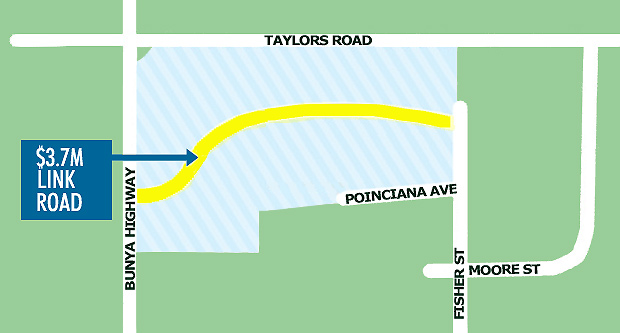
July 26, 2012
The South Burnett Regional Council has given the green light to a controversial $3.7 million “link road” in the Sunnyvale land development in Kingaroy after a week of public consultation.
The new road – and associated drainage and street lighting works – will connect the Bunya Highway with Fisher Street on the northern side of town and allow the proposed multi-million dollar, 439-lot mixed residential and commercial development to get back on track.
However, the decision to build the new road split the Council down the middle over concerns that advancing the development – which would now include a total of 250 “affordable housing blocks” – could depress real estate prices in the region and hurt other local developers, real estate agents and ordinary householders trying to sell properties.
Councillors said they had received intense lobbying from a wide variety of interested parties over the past week, and many said they found the decision an “extremely difficult” one to make.
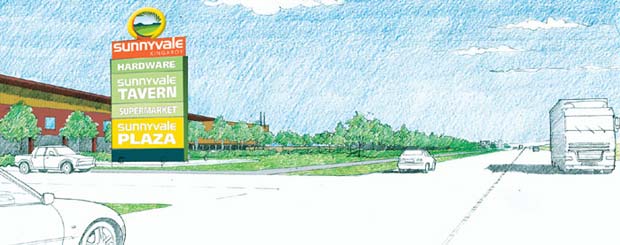
A Project In Limbo
The Sunnyvale development is the largest land development in the region and was approved by the South Burnett Regional Council in 2009.
It was brought to Kingaroy by Sunshine Coast-based Tapwood Developments, who proposed building 439 Residential A and B lots along with a business centre, shopping centre, tavern, motel, motorhome park, childcare centre, over-50s “lifestyle resort” and aged care centre on land bordered by the Bunya Highway, Taylors Road, Fisher Street and Poinciana Avenue.
Since then the project has been in limbo after the developers ran into funding difficulties caused by the global financial crisis.
To break the deadlock, in late 2010 the South Burnett Regional Council encouraged Tapwood to seek a grant from the Federal Government to help move the project forward.
At Council’s monthly meeting last Wednesday, July 18, councillors were told the Department of Families, Housing, Community Services and Indigenous Affairs (FAHSCIA) had agreed to provide a $3.7 million Affordable Housing grant towards the project on the proviso that Sunnyvale’s developers offer 250 Residential A and B lots at a discounted price to assist young couples and first home buyers to enter the market.
The land would be sold at market value but the buyers would later be refunded $16,000 for a Residential A lot or $11,800 for a Residential B lot, after settlement.
The Affordable Housing grant is part of a $450 million, five-year national program run by the Federal Government to help reduce the cost of new homes for homebuyers by assisting with infrastructure costs.
The SBRC was told the developers had agreed to meet the grant’s conditions but that the Council – which would be the lead agency in the Affordable Housing project – would have to use the $3.7 million to build the main road through the project by June 30 next year or risk losing the grant.
At that meeting, Cr Cheryl Dalton said she had some concerns about the proposed development and wasn’t sure that it would result in the best outcomes for the community.
“My concerns are for the builders, land developers and real estate agents in the area,” she said. “Sunnyvale is already approved and at some point will become a reality. But I’d like to put this back on the table for discussion so that we can get a clearer direction for the Council.”
Mayor Wayne Kratzmann said that while he agreed with Cr Dalton, he warned that the matter couldn’t be put off for too long.
“We’ll need to come to a quick decision because this can’t wait another month,” he said. “We’ll lose the $3.7 million if we don’t take it now.”
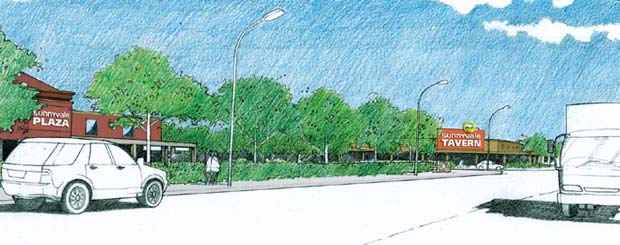
Public Meeting Voices Concerns
As a result, the Council held a public meeting at its Glendon Street chambers at 5:30pm on Monday, July 23 to gather feedback on the proposal.
The meeting was attended by representatives from Tapwood Developments, Kingaroy property developers, a Kingaroy real estate agent and a surveying company, as well as several interested onlookers, the Mayor and Councillors.
The SBRC’s Planning and Environment general manager Stan Taylor provided an overview of the project and answered questions about specific issues.
One of the major concerns raised was the effect that releasing 50 subsidised blocks each year for five years might have on the local property market.
Several speakers said that the South Burnett’s property market was depressed at the moment and expressed fears that releasing new properties – especially lots ranging from $11,800 to $16,000 below market value – would simply depress the market further.
However a representative from Tapwood Holdings pointed out that all the properties would be advertised at current market value and that only eligible purchasers would receive the Affordable Housing grant, which would be given to them after settlement.
Concern was also expressed that the development would create an “urban slum”.
But Tapwood said all purchasers would be obliged to comply with covenants which required that only high quality housing be built, and that these houses would need to be built within two years of land purchase.
Other concerns were also expressed that the development would occur in advance of employment opportunities; and that if foreclosures were made on buyers who were unable to meet repayments because of unemployment, this might also have a dampening effect on property prices.
These issues weren’t answered at the meeting, but the Council said it would take them into consideration all the same.
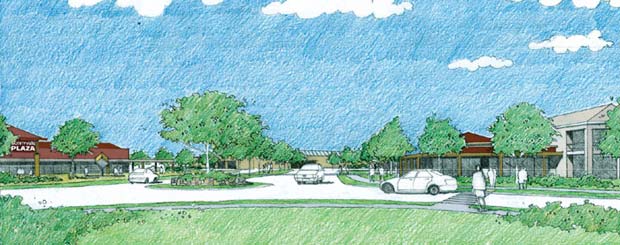
Plusses And Minuses
After this public consultation meeting, the Council held a special meeting at 4:00pm yesterday, July 25, to come to a final decision about whether to take up the $3.7 million grant or reject it.
The meeting was given a presentation on the pros and cons of the development by SBRC Business and Economic Development Manager Phil Harding which was designed to impartially outline the options before the Council and the various positives and negatives that had been identified during the public consultations.
Mr Harding summarised the position by saying Council would receive $3.7 million from the Federal Government to construct the link road, including associated road drainage and street lighting, conditional on the developers providing grants of $16,000 (Residential A) and $11,800 (Residential B) to 250 eligible landholders who purchased land and built on it within two years.
The land would be priced at current market rates and the grants would come off the land sale price after settlement.
Mr Harding said the strengths of the proposal were that if it would bring the project forward by between 10 and 15 years; that there would be minimal financial risk to the SBRC and ratepayers in doing this; and that the development would provide a boost to the local economy – particularly amongst building product suppliers and in retail sales.
This in turn would have a spin-off effect of creating more local jobs. Accepting the funding would also help bring the town a new aged care facility, local convenience shopping, medical and other professional facilities much faster than might otherwise be the case. There would also be an opportunity for other flow-on businesses to be created.
Mr Harding said that when it was finished, the development would also add between 1200 and 1300 new residents to Kingaroy, and Council’s rate base would expand by around $1 million a year.
Against this, Mr Harding said, the two major weaknesses identified were the uncertainty surrounding Sunnyvale’s potential impact on land and property prices and uncertainty about whether the developer would use local tradespeople or not.
He identified the main opportunities that accepting the proposal offered to the region as an immediate local economic stimulus package; preparedness for the next economic recovery; the Council making the most of existing funding opportunities; and the creation of opportunities for people who may not otherwise have been able to enter the market or afford to live in the area (eg. first home buyers and young families).
The proposal would also enhance the area’s affordability and liveability when compared with coastal areas or cities, and give the South Burnett a competitive point of difference to promote against other regions who lacked a similar Affordable Housing development.
Other opportunities that had been identified included improving the northern entrance to the town; improving the South Burnett’s reputation in the property industry as being “open for business” and the SBRC’s image as being an innovative and proactive Council.
Mr Harding said the proposal may also help create real estate churn (ie. current residents investing and/or moving into Sunnyvale).
The proposal could also create marketing and promotion opportunities for the region; had the potential to retain skilled workers (such as solicitors, real estate agents and tradespeople) and would also provide employment attraction opportunities for those businesses that currently struggle to attract and retain workers, particularly in retail and hospitality.
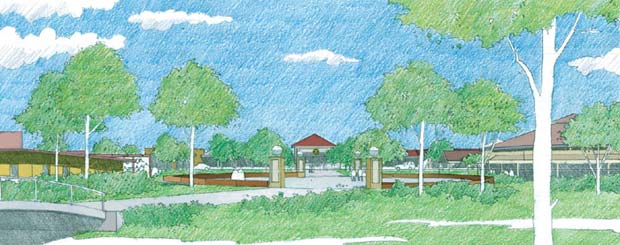
The main problems would be the ability of Council to complete the road by June 30; Tapwood’s ability to sell 50 blocks per annum over five years; the potential for repossession by banks; the possible impacts on current developers; the potential for land buyers being unable to meet conditions of purchase (ie. to build good quality housing on their blocks within two years); and the developer abandoning the project.
But Mr Harding said Council officers had looked into ways that all these risks could be mitigated or nullified, and believed they had found answers to all of them.
He conceded that there may be some initial softening in housing prices as the development proceeded, but over the longer term this would be offset by capital gains as the area grew. In addition, the impact of any softening would be minimised by the currently slow economy, where land values were already at or near the bottom of the market.
Regarding the uncertainty surrounding the use of local resources by the developer, Mr Harding said all developers worked for a commercial return and in a free market had free choice about whom they sourced services from.
However, even if they didn’t choose to use local contractors, other local businesses would still benefit through the provision of food, accommodation and building materials. Local developers and other towns in the region would also benefit from national promotion of this project.
And as land buyers would have the choice of who they used to build their houses, local tradespeople would have extra employment options if the development proceeded.
Mr Harding said FAHSCIA also recognised that the local real estate market was currently soft. So while the goal was to sell 50 blocks per annum over five years, Council had received assurances from the Federal Government that this timeframe could be extended if the target couldn’t be achieved.
The potential for real estate repossessions by banks was also low, Mr Harding said, because banks had tightened their lending polices in the wake of the GFC.
And as for possible impacts on current developers, Mr Harding said that over time the “multiplier effect” of the Sunnyvale development should prove positive for them.
If potential land buyers were unable to meet the conditions of purchase, Council had the ability to negotiate changes or extensions if required.
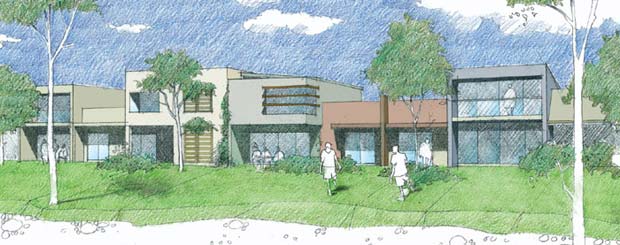
A Tight Vote
After Mr Harding’s presentation the Mayor then threw open the meeting for comment.
Cr Barry Green was the first to speak, saying he was strongly in favour of the proposal and had been ever since the Sunnyvale project first came before Council.
Cr Green said the South Burnett needed to grow its population from the current 32,000 to at least 50,000 over the next 20 years, and he saw Sunnyvale as the first step towards the “citification” of Kingaroy.
“If we don’t grow our population, the simple fact is that the costs of servicing our existing population will make this area unaffordable in the future,” he said.
Cr Cheryl Dalton said that while she wasn’t opposed to Sunnyvale per se, and she recognised that the SBRC had approved the development, she thought it would be better not to push ahead with the project at the present time because of the depressed state of the real estate market.
“I’m pro-development,” she said, “but over the last week I’ve received a lot of information from many different sources, and they tell me that right now there are 1100 houses for sale in the 4610 postcode area alone.
“So I don’t believe that releasing a few hundred blocks over the next few years will be good for this area at the present time, and for this reason I’ll be voting against it.”
Cr Kathy Duff said she agreed with Cr Green.
“Apart from the points Cr Green raised, a $3.7 million grant to build the road at no real cost to our ratepayers is a big gift to the region,” she said.
“That doesn’t happen very often and we’d be failing in our duty to ratepayers if we knocked it back.”
Cr Damien Tessmann said he’d been struggling with his decision all week, but had hardened his views in the last few days after approaches from local lobbyists who were against giving the road construction the go-ahead.
He said he was ideologically opposed to the idea that government should play a role in the property market and felt that market forces should dictate the pace of development.
“I have family members trying to sell property at the moment and the prices they’re being offered are less than what they paid in the first place,” Cr Tessmann said. “This tells me this isn’t the right time to push the market down further.”
Cr Debra Palmer said she agreed with Crs Dalton and Tessmann and that they had largely covered all the main points she’d intended to raise.
Mayor Wayne Kratzmann then spoke, saying he was very torn on the issue and had found that this decision was the hardest he’d faced in his role as Mayor to date.
“I live very close to this development,” he told the meeting, “so any downward effect on property prices is something that I’ll be sharing with all my neighbours.
“I also recognise that the current real estate market is soft, that a lot of people are doing it tough and that advancing this development may have an impact on property prices over the short term.
“However, we must remember that this Council approved this development and encouraged the developers to seek the FAHSCIA grant in the first place. So now that we have it, we’d look very bad if we turned around and knocked it back.
“Council also employs experts to advise us on what they believe is the best course of action in difficult situations, and we’d be foolish to ignore or discount the advice they give us.
“In this case, they’ve recommended that we proceed with building this road. So I think we should pay heed to what our experts tell us.”
The matter was then put to the vote, with Crs Dalton, Tessmann and Palmer opposing and Crs Green, Duff and Kratzmann supporting it.
This resulted in a deadlock, so Cr Kratzmann then used his casting vote as Mayor to give the road construction an official go-ahead.























